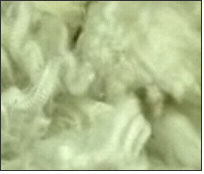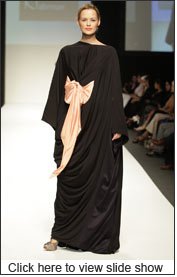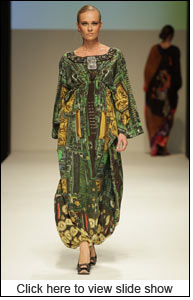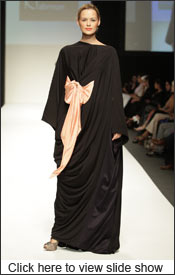 Jess A
Jess A Lola Mansil
Lola Mansil Martine Falk Andersen
Martine Falk Andersen Ala Konturek
Ala Konturek Mikko Puttonen
Mikko Puttonen
 Wool prices were slightly softer at this week's sale after the steep increase of the past few weeks, and Cape Wool's Merino indicator was down 0.8% compared to last week to close at R62,56/kg (clean). There was keen demand, however, for the finer types on offer and prices for these also increased, while the medium wools were down on last week. In Australia, the market indicator was up 1.3% compared with last Wednesday. The rand, tracking the euro, was 0.8% weaker against the US dollar compared with last week, trading at R6,96. It was also 0.8% weaker against the euro at R9,61.
Wool prices were slightly softer at this week's sale after the steep increase of the past few weeks, and Cape Wool's Merino indicator was down 0.8% compared to last week to close at R62,56/kg (clean). There was keen demand, however, for the finer types on offer and prices for these also increased, while the medium wools were down on last week. In Australia, the market indicator was up 1.3% compared with last Wednesday. The rand, tracking the euro, was 0.8% weaker against the US dollar compared with last week, trading at R6,96. It was also 0.8% weaker against the euro at R9,61.
The offering comprised 8 538 bales of which 96% was sold. Major buyers were Standard Wool SA (3 038 bales), Modiano SA (1 540 bales), Lempriere (1 509 bales), and Stucken (1 333 bales).
Average prices for good top-making (MF5), sound, long fleeces (less than 1% seed content) were as follows: 19 microns rose 1.5% to R74,73/kg; 19,5 microns gained 0.8% to close at R70,04/kg; 20 microns were 1.2% cheaper at R65,48/kg; 20,5 microns dropped by 1.6% to R64,15/kg; 21 microns were down 1.9% to R62,86/kg; 21.5 microns were 1.9% softer at R62,45/kg and 22 microns were 1.2% cheaper at R61,54/kg.
Approximately 10 000 bales will be offered at next week's sale.
 Nike announced the launch of “Rise,” a new multi-media campaign featuring reigning two-time NBA MVP LeBron James speaking in his own voice. In the film, he addresses his off-season controversy head-on and focuses on the road ahead.
Nike announced the launch of “Rise,” a new multi-media campaign featuring reigning two-time NBA MVP LeBron James speaking in his own voice. In the film, he addresses his off-season controversy head-on and focuses on the road ahead.
"We’re celebrating his courage to forge his own journey even when others may have disagreed with his decisions. It’s this Just Do It spirit that defines LeBron and Nike as we strive to inspire all young athletes.”
Rise features several sides of LeBron’s personality: athlete, competitor, comedian and businessman. It opens with him sitting in a chair in front of the backdrop of “The Decision” asking, “What should I do?” Throughout the film LeBron rhetorically asks everyone for their opinion and each scene reflects opinions that have been expressed.
A notable scene includes LeBron saying, “I am not a role model,” borrowing a famous line from fellow Nike athlete Charles Barkley. LeBron also humorously asks, “Should I try acting?” He gets advice from Don Johnson, an actor best known for his role as Detective Sonny Crockett on the iconic 80’s TV series Miami Vice, who advises him that things will get better with time. LeBron also reads part of a soulful poem written by world-renowned poet, Dr. Maya Angelou. The film ends with LeBron driving to the net and saying in response to everyone, “Should I be who you want me to be?”
"In Rise, we amplify LeBron’s voice,” said Davide Grasso, Vice President of Global Brand Marketing. “We’re celebrating his courage to forge his own journey even when others may have disagreed with his decisions. It’s this Just Do It spirit that defines LeBron and Nike as we strive to inspire all young athletes.”
The campaign will debut globally with a 90-second film on YouTube on Monday, October 25th and will subsequently air on TNT Tuesday, October 26, during one of the most highly anticipated games of the season, the opener between Miami and Boston. The campaign will also air during sports and entertainment broadcasting across national networks into November with the main placements to include TNT, ESPN, and Sports & Youth Cable (BET, Comedy Central, MTV2 Fuse, Adult Swim, Fox Sports, ESPN Family, TNT NBA, NBA TV).
For most shoemakers in Dongguan city the impact of economic crises has been gone, rebounded footwear orders are not pleased thing for the owners of shoemakers because the shortage of labor remains for several months.
A job fair took place in Houjie plaza on October 24 that attracted few job seekers compared with more than 4000 jobs provided by enterprises. One of shoemaking owner said on the job fair we are here for employing a large numbers of worker, few of workers came to us for jobs.
The Dongguan Leather and Footwear Association said that labor shortage in Dongguan city can’t be ease in a short time, because of this reason many shoemakers have to cut the orders book and reduce production.
This is not the biggest problem for our shoemakers, fluctuation of RMB and raw material price hiking absorb our profits significantly, said Ms Zhou, in a foreign trade department of Liaoxia Footwear Sale Center, and adding that upper leather soared 30% in recent three months.
One of shoemaking owners said although we received enough orders, it seems our business quite good but our profit becomes less and less, if such situation continues going on we can’t stand such pressure.
Wenzhou, the leading shoe exporting city in China's Zhejiang Province, shipped 394 million pairs of shoes worth US$1.9 billion in the first seven months of this year, up 33.2% year-on-year, according to the city's customs.
The EU and Eastern Europe remain the biggest overseas market for Wenzhou shoes although exports to the US have seen rapid growth.
In the first seven months of this year, Wenzhou exported 131 million pairs of shoes to the EU, up 20.5% year-on-year, accounting for 33.2% of Wenzhou's total export of shoes during the period. That compared to exports of 42 million pairs of shoes to the US, up 85.3%, 22 million pairs to Russia, up 41.7%, and 30 million pairs to Croatia, up 96.2%.
The real leather shoes, which are relatively expensive, are getting a cold response from foreign buyers, despite some recovery in demand there, said Jin.
The share of high-end shoes in the total value of Wenzhou's total shoes export has steadily dropped to 17%, a drop of 1.7 percentage points from the same period last year.
Some foreign merchandisers are splitting orders to give themselves greater leeway and opportunities to change suppliers.
Major rivals like Indonesia, Vietnam and India, which all enjoy cheap labor costs, are emerging in a more advantageous position for international footwear markets.
The EU's market barriers have forced Wenzhou shoemakers to turn to the US market.
But economic recovery in Russia and Ukraine has provided the industry with a glimmer of hope.
It's understood that many Wenzhou companies have shifted to the newly-opened retailer Russian Home following the closure of the Cherkizovsky wholesale market. Deliveries are expected to reach their peak in the second half of the year, based on cyclical market patterns.
Real leather shoes are high-end products but are not generally affordable in the emerging ASEAN markets which Wenzhou manufacturers are pinning their hopes on.
However, Mainland shoe manufacturer Kangnai and other companies have begun to test the water in ASEAN countries by first opening their own stores in Vietnam.
At the China Wenzhou Brand Name and Quality Products Expo held in Malaysia recently, over 160 Wenzhou companies, including shoes manufacturers, introduced themselves to ASEAN markets with the idea of using Malaysia as a springboard.
Scarcity of irrigation water will affect the standing crops of cotton in various areas of Punjab and Sindh. Water scarcity will cause 15 percent production loss in these regions which will amount to around 1.2 million of cotton bales, stated the Pakistan Cotton Ginners Association (PCGA) recently.
Punjab is suffering from water stoppage by the irrigation department, while Sindh is dealing with water shortage, informed Mr. Rana Abdul Sattar, PCGA patron in chief and member of Sindh Assembly.
Mr. Sattar added that the Punjab Irrigation Department has stopped irrigation water for cotton crop cultivated in Rajanpur, Bahawalpur, Rahimyar Khan, Duniyapur and adjoining areas of these regions to provide water to the wheat crop, for which sowing has been stared since the third week of October and will continue till November 20.
He recommended the Punjab Agriculture Minister, Mr. Ahmed Ali Allak to pay attention towards the situation and to use the water management system for proper water supply to the cotton crop. Non-availability of water in Punjab province would affect 10 percent of this crop, which accounts for around 80 percent of the country's overall cotton production.
Water supply to these cotton cultivated regions should be assured by the month of November so that the country??s total production could surpass 12.10 million in the fiscal 2010-11, added Mr. Sattar.
Brussels might not have the couture cachet of London, Paris or Milan, but a small group of avant-garde fashionistas is giving the Belgian capital an underground designer edge.
Using unusual and even surreal spaces such as thrift shops, a bakery, a bicycle repair shop and a former electricity power plant to show their work, the young designers and design students are giving Brussels a fashion buzz.
"In Brussels, what is unique is Brussels itself," said Veronique Heene, the coordinator of Modo Brussels Fashion Designers Trail, a bi-annual fashion and art exhibition.
"It's a small town. It's not a big, big town. It's a mix of culture, really an international city even if it's a small city, and many people are coming from elsewhere."
La Centrale Electrique, the first electricity plant in Brussels, is the starting point of the trail, which leads throughout the city's downtown and the funky Rue Dansaert district, taking in 60 exhibition spaces.
In the vast Centrale Electrique, at the end of a neon-yellow hall, a single mannequin stands decked out in electric-bright yellow neon. In an adjoining room, a crowd of mannequins are dolled up like sea creatures, one like a jellyfish, another a seahorse, still others like cascades of water and fire.
An ensemble near the entrance looks like a sequined dragon. It only uses two colors, green and gold, but the light reflecting off the sequins gives off a rainbow of colors.
Scattered along the route are boutiques and galleries displaying art, photographs, paintings, graphic designs and even studios for DJs to "show" their audio work, making the fashion trail a multimedia design experience.
Some exhibits and art spaces will be open just for a few days, while others will remain open for several weeks.
"The students try to go out of what you expect, and after that, they find a sort of liberty. After that, they can find their own style. They can find what they like, how they will work," Heene said of one design school's exhibit.
Stores along the route stay open late for the duration of the exhibition, receiving visitors who pay 8 euros ($11.23) for a ticket to follow the trail in whatever order they want.
"It's very special that this shop is open on a Sunday," said Kitty Sokal of Brussels, who picked her way through a flurry of venues.
Her first stop was the workshop of Christophe Coppens, which sells hats and other accessories, where Sokal picked up a funky black knitted hat.
"It's like something you put on a teapot," she said. "It's very warm -- it's creative -- and the textures are very nice. You see three layers, and if you feel, it's very soft."
Emilie Beaumont, who left design school three years ago, chose a bicycle shop, which was formerly a cinema, as the setting for her first collection of men's clothes.
"It's historic, and it's good for events because there's a lot of space. Now it's a bicycle shop where you can repair your bicycle. I find it was nice to have a man's collection in a bicycle shop because my clothes are more street," she said.
Beaumont drew the inspiration for her collection from superheroes. The coats resemble capes with all the folds of fabric, and the shirt designs look like the lines of muscles.
This is Modo Brussels' 10th fashion designers' trail. While it happens every two years at the moment, such is its popularity that organizers are hoping to make it an annual event.
Heene said the event is designed to appeal to anyone who has even a passing interest in fashion.
"It's an interesting event because the professionals, the journalists and the public, even my mother, can find something interesting in it."
 Nabrman, or "white flower", is the brainchild of two Emirati women, who showcased their Spring/Summer collection of abayas on Day 3 of Dubai Fashion Week during 24th October, 2010 to 28th October, 2010 at atlantis, United Arab Emirates.
Nabrman, or "white flower", is the brainchild of two Emirati women, who showcased their Spring/Summer collection of abayas on Day 3 of Dubai Fashion Week during 24th October, 2010 to 28th October, 2010 at atlantis, United Arab Emirates.
The classic loose-fitting and flowing abayas retained their shape and form, whilst being embellished with subtle prints and satin sashes. Three of the outfits incorporated light digital printing of green and blue bands in varying intensities on their sleeve ends as well as along the edges of the skirts. The 16 piece collection inserted hints of glamour while preserving their essence of minimalism.
The abayas presented were modest but equally high on the elegance quotient, representing the personality of the UAE-based brand. The models were accessorized with minimal jewellery and black shoes so as not to distract the focus from the abayas on display.
Daywear abayas were accompanied by satin sashes in baby pink, violet, brown and ivory. The sashes were draped over the abayas in innovative ways, resulting in a variety of silhouettes that transformed the traditional abaya into works of art. The eveningwear abayas factored in more glamour as they were complemented by brightly coloured satin gowns that were overlaid with the sheer black fabric, touched up with a shimmering finish.
The collection was clearly aimed at the modern Emirati woman who wishes to keep up with the latest trends, while holding steadfast to her of values of modesty and simplicity.
 Known for his fascination with Arabia, designer Shrekahnth, in his third year at Dubai Fashion Week - DFW during 24th October, 2010 to 28th October, 2010 at atlantis, United Arab Emirates, presented a collection inspired wholly from Islamic art.
Known for his fascination with Arabia, designer Shrekahnth, in his third year at Dubai Fashion Week - DFW during 24th October, 2010 to 28th October, 2010 at atlantis, United Arab Emirates, presented a collection inspired wholly from Islamic art.
The “Arabian Nomad” collection experimented with digitally printed fabrics of pure silk, chiffon silk and satin silk. Robes in pale yellows, deep greens, pinks and blues flaunted flowing hemlines with square necklines. Busts carried motifs of flying eagles and digital fabric prints were enhanced so as to appear like wings on the back of the outfits.
With decorated war horses and other Islamic art elements emblazoned on the outfits, the designer was inspired by fabrics and textures dating more than 600 years, which were used for historical Islamic embroidery and artwork. In trying to replicate nomadic textures with digital art, the designer also experimented with the famous Russian Matryoshka dolls on the outfits, bringing about a strategic blend of Arab heritage with Russian culture.
The geometric patterns of the outfits replicated Islamic culture and art, while indulging in prints representing painted glass motifs as well as digital prints resembling cellular phone circuit boards.
The “Arabian Nomads” collection was followed by Megha Grover’s Spring/Summer collection - a set of pure white outfits. Futuristic silhouettes merged with classic cuts as the collection displayed a variety of white ensembles ranging from short tube dresses to long gowns and pantsuits ending in jodhpurs.
The crisp white collection of 15 outfits was embellished with crystals at the hemlines, sleeve ends as well as pant legs. A suit in white featured low cut pockets encrusted with the precious stones, as well as large necktie like pieces in full sparkle. With hints of Bohemian elements, the outfits of silk, satin and lace pointed to an elegant, yet laidback summer.
Scarcity of irrigation water will affect the standing crops of cotton in various areas of Punjab and Sindh. Water scarcity will cause 15 percent production loss in these regions which will amount to around 1.2 million of cotton bales, stated the Pakistan Cotton Ginners Association (PCGA) recently.
Punjab is suffering from water stoppage by the irrigation department, while Sindh is dealing with water shortage, informed Mr. Rana Abdul Sattar, PCGA patron in chief and member of Sindh Assembly.
Mr. Sattar added that the Punjab Irrigation Department has stopped irrigation water for cotton crop cultivated in Rajanpur, Bahawalpur, Rahimyar Khan, Duniyapur and adjoining areas of these regions to provide water to the wheat crop, for which sowing has been stared since the third week of October and will continue till November 20.
He recommended the Punjab Agriculture Minister, Mr. Ahmed Ali Allak to pay attention towards the situation and to use the water management system for proper water supply to the cotton crop. Non-availability of water in Punjab province would affect 10 percent of this crop, which accounts for around 80 percent of the country's overall cotton production.
Water supply to these cotton cultivated regions should be assured by the month of November so that the country??s total production could surpass 12.10 million in the fiscal 2010-11, added Mr. Sattar.
 Nabrman, or "white flower", is the brainchild of two Emirati women, who showcased their Spring/Summer collection of abayas on Day 3 of Dubai Fashion Week during 24th October, 2010 to 28th October, 2010 at atlantis, United Arab Emirates.
Nabrman, or "white flower", is the brainchild of two Emirati women, who showcased their Spring/Summer collection of abayas on Day 3 of Dubai Fashion Week during 24th October, 2010 to 28th October, 2010 at atlantis, United Arab Emirates.
The classic loose-fitting and flowing abayas retained their shape and form, whilst being embellished with subtle prints and satin sashes. Three of the outfits incorporated light digital printing of green and blue bands in varying intensities on their sleeve ends as well as along the edges of the skirts. The 16 piece collection inserted hints of glamour while preserving their essence of minimalism.
The abayas presented were modest but equally high on the elegance quotient, representing the personality of the UAE-based brand. The models were accessorized with minimal jewellery and black shoes so as not to distract the focus from the abayas on display.
Daywear abayas were accompanied by satin sashes in baby pink, violet, brown and ivory. The sashes were draped over the abayas in innovative ways, resulting in a variety of silhouettes that transformed the traditional abaya into works of art. The eveningwear abayas factored in more glamour as they were complemented by brightly coloured satin gowns that were overlaid with the sheer black fabric, touched up with a shimmering finish.
The collection was clearly aimed at the modern Emirati woman who wishes to keep up with the latest trends, while holding steadfast to her of values of modesty and simplicity.